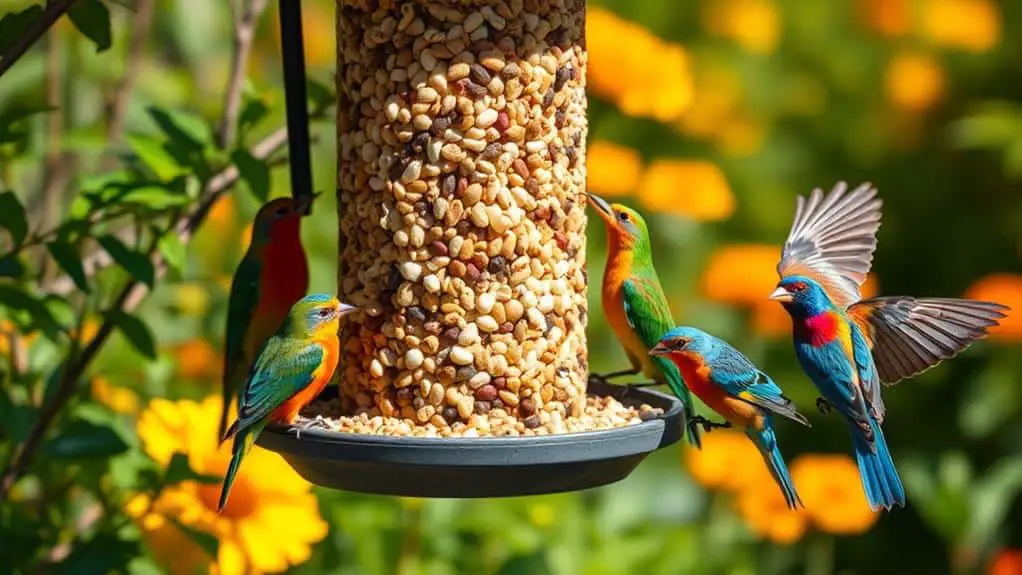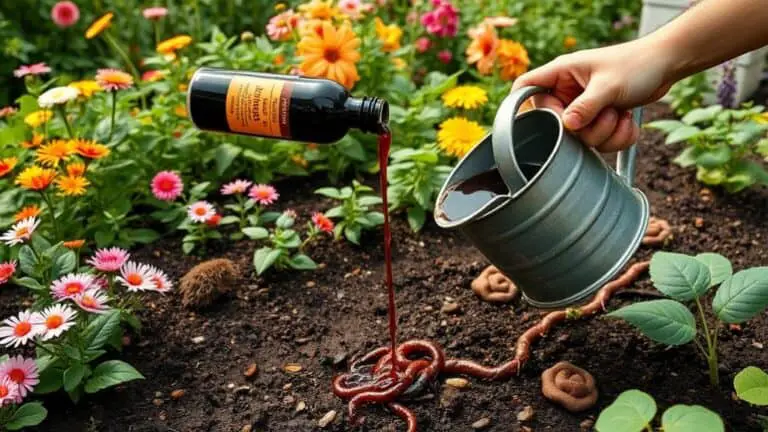The Kitchen Staple Thatll Make Your Bird Feeder Irresistible
I've discovered an often-overlooked kitchen staple that can transform your bird feeder into a magnet for a variety of feathered friends. It's not only incredibly effective but also affordable and easy to find. This simple addition can enhance the nutritional value of your bird feed, especially during the colder months when birds need extra energy. If you're curious about how this everyday item can attract a diverse array of birds to your backyard and improve your birdwatching experience, you'll want to know more about this fascinating topic.
Understanding Bird Preferences

When setting up a bird feeder, it's crucial to understand what different bird species prefer. To make your bird feeder a hit, knowing which seeds attract which birds is key.
Black oil sunflower seeds are a favorite among many species due to their high oil content and soft seed coat. If you're trying to attract smaller backyard birds like goldfinches, use fine sunflower chips—they're 100% edible and don't create waste.
Cardinals and house finches love safflower seeds, which also keep squirrels and blackbirds away. Ground-feeding native sparrows enjoy millet scattered on the ground.
Blue jays, on the other hand, go for inshell peanuts, providing food and alerting other birds to predators. By tailoring your bird feeders, you'll create a thriving bird sanctuary.
Nutritional Benefits of Black Oil Sunflower Seeds
You'll be amazed at how black oil sunflower seeds can boost the health of your feathered friends.
These seeds are packed with high energy, attracting a wide variety of birds to your feeders.
Plus, they provide essential nutrients like vitamin E and fatty acids that keep birds strong and vibrant.
High Energy Content
Black oil sunflower seeds are a powerhouse of nutrition for birds, thanks to their exceptionally high oil content that provides an essential energy boost, especially during the colder months.
These seeds contain approximately 40-50% fat, making them perfect for birds needing extra energy to stay warm. During cold weather, birds burn more calories to maintain body heat, and the high energy content of these seeds helps them thrive.
To keep your seeds fresh and nutritious, store them in a dry place. This guarantees they last up to a year, providing a reliable food source for your feathered friends.
Rich in protein too, these seeds support birds' growth and overall health, making them an excellent choice for your bird feeder.
Wide Bird Attraction
Bird feeders brimming with black oil sunflower seeds are a magnet for a diverse array of bird species.
These seeds attract a wide variety of birds, from small finches to larger cardinals, thanks to their soft seed coat and high oil content.
When you fill your bird feeder with black oil sunflower seeds, you're offering a food source that's not only highly preferred but also versatile enough for different feeder types.
This means you can easily accommodate more birds in your garden.
Plus, since these seeds are 100% edible, there's no waste left behind, keeping your feeding area clean.
Essential Nutrients Provided
While black oil sunflower seeds are excellent for attracting a wide variety of birds to your garden, their benefits extend far beyond just being a bird magnet.
These seeds are packed with essential nutrients that birds need to thrive. They've a high nutritional value, providing about 40-50% fat, which is vital for birds' energy, especially during cold months.
They also offer around 15-20% protein, supporting muscle development and overall health. Plus, black oil sunflower seeds contain essential vitamins like B vitamins, and minerals such as magnesium and zinc, which help birds' metabolic functions and immune systems.
Their soft seed coat makes them easy for smaller birds to eat, enhancing their feeding experience and keeping them coming back for more.
Attracting Diverse Bird Species

To attract a variety of bird species to your yard, try using uncooked porridge oats in your feeders.
Scatter oats on the ground for birds like doves and sparrows, and mix oats with seeds to appeal to even more birds.
Oats for Ground Feeders
Oats bring a sense of versatility to bird feeding, especially when aiming to attract ground feeders like sparrows and doves. By scattering oats, you can enhance backyard bird diversity and create a welcoming environment.
Here's why oats are a great choice:
- Nutrient-rich: Uncooked porridge oats provide essential slow-release carbohydrates and proteins, easily digestible for various bird species.
- Attractive to ground feeders: Birds like sparrows and doves are particularly drawn to oats.
- Cold weather energy: Oats offer valuable energy during colder months when food is scarce.
- Easy maintenance: Regularly replenishing and ensuring oats remain dry prevents spoilage.
Combining Seeds Strategically
Ground feeders like sparrows and doves enjoy oats, but to attract a wider variety of bird species, combining seeds strategically is key.
By mixing black oil sunflower seeds with safflower seeds, you can attract cardinals and house finches while deterring squirrels due to safflower's bitter taste.
Adding fine sunflower chips guarantees minimal waste and specifically caters to smaller birds like goldfinches.
Including shelled peanuts provides high-energy nutrition and attracts woodpeckers and chickadees, making your feeder even more diverse.
Scatter millet on the ground to create a natural feeding environment for native sparrows.
Bird Behavior Insights
Ever wondered why certain birds flock to specific types of feeders? From my experience, understanding bird behavior can make your feeding efforts more successful.
Make sure to offer a variety of foods to attract diverse species. Here's a quick guide:
- Uncooked porridge oats: Attract blackbirds, sparrows, and finches.
- Oats mixed with black oil sunflower seeds: Provides energy-rich food for many birds.
- Ground-feeding with oats: Appeals to sparrows and doves who prefer foraging on the ground.
- Safflower seeds: Draws in cardinals and house finches.
Feeding Techniques for Success
How can you make your bird-feeding efforts more successful and enjoyable? First, consider feeding frequency. Birds tend to be most active early in the morning and late afternoon, so try to refill your feeders during these peak times.
Next, think about feeder types. Ground feeders like sparrows and doves will appreciate uncooked porridge oats scattered on the ground. For a nutritious blend, mix oats with black oil sunflower seeds in your feeders.
One of my favorite birdwatching tips is to create DIY suet blocks with oats and other bird-friendly ingredients, especially for colder months.
Also, make sure to clean and maintain your feeders regularly to keep the food fresh and prevent mold.
Happy birdwatching!
Optimal Bird Feeder Placement

When placing bird feeders, I always look for a sheltered spot to protect them from harsh weather and keep the birds safe.
It's also important to position the feeders near trees or shrubs so birds can quickly escape from predators. This makes them feel secure and encourages them to visit more often.
Sheltered Spot Benefits
Placing bird feeders in sheltered spots is crucial for creating a safe and inviting environment for our feathered friends. By choosing locations near trees or shrubs, we can offer birds protection from predators and harsh weather.
Here's why it's important:
- Feeder Camouflage: Natural elements help conceal feeders, making birds feel secure.
- Shelter Materials: Trees and shrubs act as windbreaks, keeping seeds dry and appealing.
- Predator Awareness: Elevated feeders give birds a clear view, helping them spot danger.
- Seasonal Adjustments: Moving feeders based on seasonal changes guarantees continued success.
Natural Cover Importance
Strategically placing bird feeders near natural cover like shrubs or trees plays an essential role in attracting and protecting our avian visitors.
Birds need safe spots to hide from predators, making feeder placement tips important for creating a welcoming space. By positioning feeders within 10 to 15 feet of natural cover, we can greatly enhance feeder utilization through effective predator avoidance strategies. This distance allows birds to quickly retreat if startled, encouraging them to stay longer and feed more comfortably.
Enhancing natural habitat with native plants around the feeders not only provides additional food sources, like insects, but also improves the overall ecosystem.
These simple adjustments make bird watching more enjoyable and create a safer haven for our feathered friends.
Seasonal Feeding Strategies
Seasonal feeding strategies are essential for keeping your backyard a haven for birds throughout the year.
By adjusting the food you offer, you can attract and support a variety of bird species. Here are some tips:
- Winter feeding techniques: Offer high-energy foods like black oil sunflower seeds and suet cakes to help birds survive the cold.
- Spring and summer: Use fresh fruits and mixed seed blends to cater to nesting and breeding birds.
- Monitor bird populations: If you see more goldfinches, increase nyjer seeds, their favorite.
- Autumn feeding: Ground feed with millet for native sparrows.
Supporting birds during their seasonal migration patterns guarantees a lively and vibrant backyard year-round.
Keep those feeders clean and full!
Preventing Common Feeding Issues

Keeping your bird feeders in top shape is essential to prevent common feeding issues that can deter our feathered friends.
First, always follow good feeder maintenance tips by cleaning your feeders regularly with a mild solution. This prevents mold and disease, ensuring a safe environment.
Next, implement pest deterrent methods like using squirrel-proof feeders or baffles to keep unwanted critters away.
For seed freshness strategies, refill feeders with fresh seed before they run out to keep birds visiting consistently.
Monitoring feeder activity helps spot changes in bird behavior, indicating potential issues such as spoiled food or poor feeder placement.
Storing Seeds Properly
Maintaining clean and well-stocked feeders is only part of the equation in attracting and keeping birds in your yard. Proper seed storage is essential for keeping your feathered friends happy and healthy.
Here are some seed longevity tips to guarantee your seeds remain fresh:
- Store seeds in airtight containers to control moisture and keep pests out.
- Keep seeds in a cool, dry place below 70°F to prevent spoilage and mold growth.
- Regularly check seeds for spoilage and toss any that smell off or show mold.
- Use clear or labeled containers to monitor seed levels and avoid using stale seeds.
Enhancing Birdwatching Experience

Diving into birdwatching, you'll find that incorporating uncooked porridge oats into your bird feeder can truly elevate your backyard experience.
Adding oats not only attracts a wider variety of birds, like blackbirds, sparrows, and finches, but also promotes engaging birdwatching activities. It's a delight to see how different species interact and feed.
This hobby becomes even more rewarding when shared with family, offering countless educational opportunities. Together, you can learn about the birds' feeding habits and natural behaviors.
Plus, oats are an affordable addition, making frequent refills easy on the budget.
Supporting Local Wildlife
As we explore the benefits of oats in bird feeders, let's also consider how this simple kitchen staple can support local wildlife.
By using oats, we can foster community engagement and educational opportunities. Here's how:
- Attracting Birds: Oats draw various granivorous birds, boosting biodiversity awareness.
- Nutritional Support: They provide essential nutrients, aiding birds' health and energy.
- Winter Aid: During colder months, oats offer vital energy when natural food is scarce.
- Disease Prevention: Regularly replenishing oats and maintaining cleanliness reduces disease transmission.
Frequently Asked Questions
How Can I Make My Bird Feeder More Attractive?
To make my bird feeder more attractive, I use diverse bird feeder designs and natural bird food. I mix seasonal bird feeding options like black oil sunflower seeds and porridge oats, ensuring it appeals to various bird species throughout the year.
Will Birds Eat Old Fashioned Oatmeal?
Yes, birds will eat old-fashioned oatmeal. It's packed with health benefits like slow-release carbs and protein. For bird feeding tips, mix oats with seeds and keep feeders clean. Oatmeal is a natural bird attractant, enhancing backyard diversity.
Why Put Oatmeal in Bird Feeders?
I put oatmeal in bird feeders because its benefits include boosting bird health with essential nutrients. It supports their feeding habits by providing energy and attracting various species, making my backyard a vibrant and lively place.
What Attracts Birds to Their Food?
Bird feeding preferences often depend on seed varieties and feeder placement strategies. I've found that offering a mix of fresh seeds like sunflower and millet, and placing feeders in safe, visible spots, really attracts diverse bird species.
Conclusion
By adding uncooked porridge oats and black oil sunflower seeds to your bird feeder, you'll attract a variety of birds and support local wildlife. It's an easy and affordable way to enhance your birdwatching experience. Remember to place your feeder in a safe, accessible spot and keep it clean to avoid common issues. With these simple steps, you'll create a welcoming space for birds and enjoy the beauty of nature right in your backyard.






